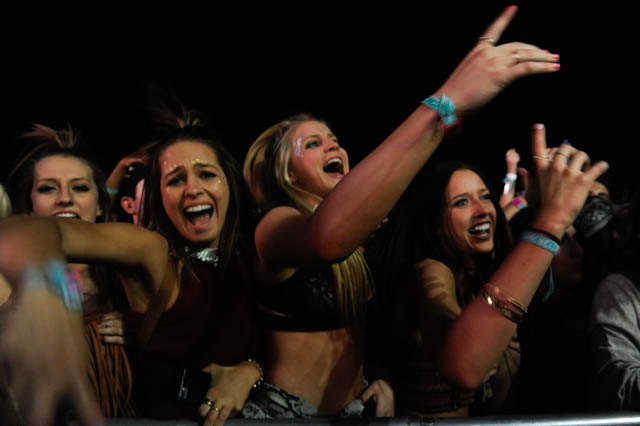All photos by Timothy Norris
It’s 5 AM the first night of Coachella, and Jack Ü is still trending on Twitter. Mostly, people are crying. They are crying because they were there, they are crying because they are not there, they are crying because their dads are yelling at them for crying while watching the Coachella live stream, because Jack Ü.
Videos by VICE
Imagine, if you will, a giant 1984 Macintosh 128k, from which human letter jacket Diplo descends carrying a proportionately enormous floppy disk. He teeters for a moment, then stumbles backwards. “DON’T DO DRUGS JUST TAKE SOME” flashes in digital letters across a retro desktop screen. An anthropomorphic bottle of Febreeze joins him on stage and begins to dance.
“Jack Ü is sponsored by Febreeze everyone is fresh out hereeee!” Skrillex yelps.
The whole to-do is the hyperbole of commercial EDM personified. From the stage design, to Kanye’s sloppy seconds surprise appearance, to a set that was essentially synth-fried clips of your favorite parts of your favorite songs, everything about Jack Ü is blown up to absurdist proportions and stripped of meaning.
It’s not all bad—there are some bangers. But they arrive in schizophrenic 30 second clips, like a future frat boy’s bar mitzvah playlist zapped in a Bullet blender with a bottle of Axe Gold Temptation™, and filtered through a flip phone from 2007.

As these things go, there are more questions than answers: How many people know that’s a computer? Do they know what a floppy disk is? Is this actually kind of brilliant Dadaist performance art, or is it trash? DO SKRIPLO ENJOY THEIR UNSETTLING EFFECT? Do your parents know you’re here? Aren’t you cold? Am I old?
In recent years, Coachella’s Outdoor Stage has come to draw a crowd comparable to or even larger than the main Coachella Stage, less a divide now between headliners and second tier acts than the divide between the youngs—that is, people of school age—and the olds—people with enough money, or clout, to be there.
Among the former, the teens in particular are out here for it, crying, shrieking, hands outstretched, perfect teeth bared in ululations of religious ecstasy, tears dissolving perfectly applied flash tattoos into a sparkling gold sludge of dust and mascara smeared down their necks and chests. But what they’re out here for isn’t clear.
“You know the words! Sing it!” Skrillex calls out during “Take Ü There,” just before cutting out the vocals. Then, silence. The beat goes on.
A few minutes later, we’re approached by a 52-year-old in a bandana and fanny pack.
“It this trap music?” he asks.
“It’s Skrillex and Diplo.”
“Oh. If I had known it was Skrillex, I would’ve run the other way.”

The crowd is also running…somewhere. They go towards the stage, in waves, and just as quickly, they leave. Then they come back, as if having collectively forgotten their sweatshirts. They’re not dancing so much as they can’t sit still, or decide what they want to do. A glimmering, shirtless bro pops up and pogos in front of me during a pitched-out minute or so of “Where Are Ü Now,” then turns around and wanders away to nowhere in particular. At the far edge of the crowd, a couple is making out atop a pile of trash, dry humping in the solitude of nothing and no one around them but crushed water bottles. A glover spends a minute or two frantically working his magic, then stops to check his phone. This happens three times over the course of two songs. Are we having fun yet?
In a few minutes, across the way on the main stage, James Murphy will lament losing his edge, losing his New York, losing mind. But the existentialism and sentimentality of LCD Soundsystem’s brand of dance was long ago rendered moot by the more immediate reward of the bass drop. This isn’t his thinking man’s dance music. It’s not even really the LED spectacle sparked by Daft Punk’s legendary 2006 pyramid performance, set aflame by the likes of David Guetta and Knife Party in the Sahara tent, and burned into ’10s pop cultural ubiquity. It’s the hyperbole of Coachella’s collective id, distilled into a frenetic goo of dubstep mash-ups and selfie sticks, scraped from the overcooked remains of mainstream festival culture’s takeover, and repackaged as instant gratification. It’s the internet’s wag the dog moment.
If the culture of commerical EDM is, at its core, about escapism, it’s hard to tell where they’re escaping to at this point; amidst the remixed excess, the night plays out like a feedback loop of hedonism and impluse at last approaching its singularity. Maybe there’s nowhere left to go.
Andrea Domanick will take ü there. Follow her on Twitter.
More
From VICE
-

Collage by Vice -

Fear Buck / X.com. -

TikTok -

Lauryn Hill in concert in 2023. Photo by Antione Delerme/Soul B Photos/Shutterstock.
